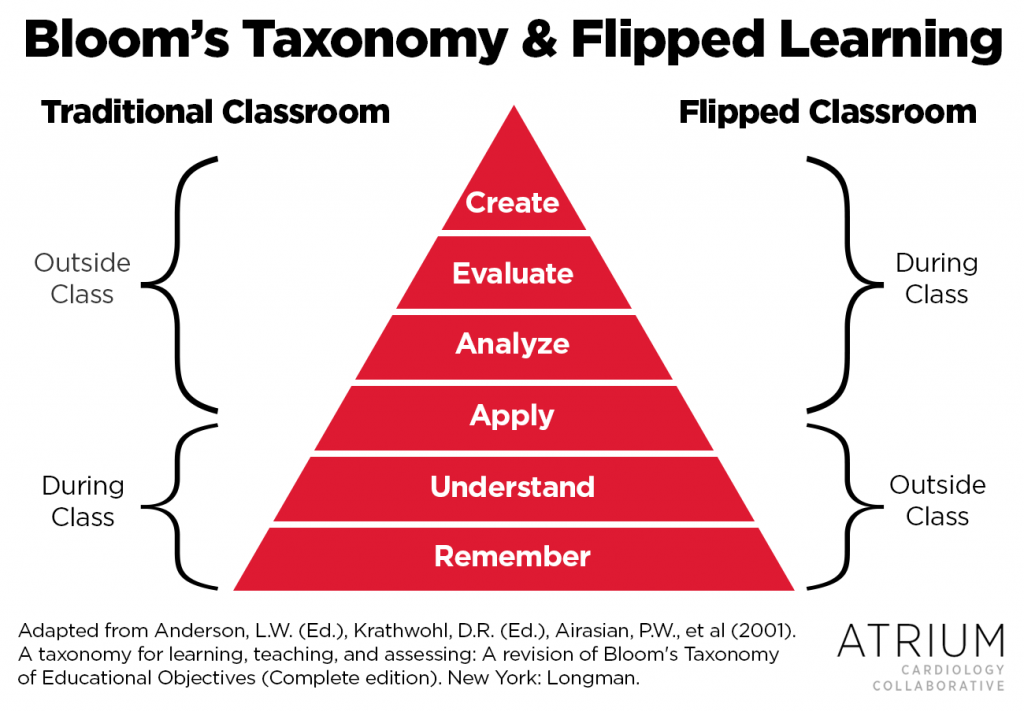Share this post:
Authors: Kristin Watson, PharmD, BCPS-AQ Cardiology and Sandeep Devabhakthuni, PharmD, BCPS-AQ Cardiology
The following is Part 1 of a 2-part series. Part 2 is Flipping Your Rotation (Part 2 of 2): From the Classroom to the Clinic.
Active learning strategies are often integrated into the classroom setting in order to improve student performance and promote self-directed learning. A variety of active learning techniques exist, such as “Think, Pair, Share”, role playing, and games1 (Stay tuned for an upcoming blog about techniques in the coming months). One strategy that has become increasingly popular is the flipped classroom model.
To help explain flipped learning, let’s briefly review Bloom’s taxonomy (Figure 1), a framework for categorizing educational goals across three domains of learning: cognitive, affective, and psychomotor.2 The purpose of this framework is to promote higher forms of learning, such as analyzing and evaluation, rather than just recalling facts. In the classroom, educators devise strategies to cover all three domains using either a traditional or flipped teaching model. When using the traditional classroom technique, students are challenged to remember, understand, and apply concepts as part of a didactic lecture. Then, they are expected to complete homework assignments to engage in higher-order learning. However, in the flipped classroom model, students are exposed to content prior to class, where they engage in basic levels of learning. Then, in the classroom, the instructor facilitates activities (e.g., case-based discussion, problem-based learning) to engage students in higher-order learning.
Let’s use disease state pathophysiology and therapeutics as an example of how one might teach using a traditional versus flipped classroom model (Table 1). In the traditional classroom model, instructors typically provide learners with the core concepts during class and learners apply this material on their own after the didactic session. In the flipped classroom model, the instructor might provide learners with materials to review before class (e.g., a pathophysiology and treatment overview). These “flipped” materials can be provided in a variety of ways, such as recorded lectures, assigned readings, or even interactive web-based tools. Time in the classroom is then dedicated to active learning, because the fundamentals were covered outside the classroom. 3,4 As a result, students and instructors spend more time engaging in higher order learning.
Table 1. Example Teaching Methods for a Given Disease State
| Content | Traditional Model | Flipped Model Examples |
| Pathophysiology | Lecture in class | Record lecture and require students to review prior to class
and Provide list of questions for students to answer before coming to class |
| Therapeutics | Lecture in class | Record lecture and require students to review prior to class
or Assign readings (e.g., treatment guidelines) and create an interactive module for students to complete prior to class |
| Case-based Application | Incorporate case into lecture or provide as homework | Live discussion session with the instructor |
Benefits of the Flipped Approach5-8
- Promotes self-directed learning
- Potentially improves student performance
- Often bridges the gap between generational differences in learning styles
- Reduces student multitasking
- Places focus on active learning
- Increases opportunities for students to engage with faculty and peers
- Allows for unique assessment strategies/opportunities
Potential Challenges or Limitations of the Flipped Approach 5-8
- Requires more time to create “flipped” activities
- May require new technology
- May invoke fear of increased workload among learners
- Can be more challenging with a large class size
- Requires accountability that students can complete assignments on their own
As cited in the paper by Rotellar and Cain,4,9 we feel the following quotation from Benjamin Franklin accurately reflects the value of the flipped classroom:
“Tell me and I forget, teach me and I may remember, involve me and I learn”.
 |
Kristin Watson, PharmD, BCPS-AQ Cardiology
|
 |
Sandeep Devabhakthuni, PharmD, BCPS-AQ Cardiology
|
References:
- Stewart DW, Brown SD, Clavier CW, Wyatt J. Active-Learning Processes Used in US Pharmacy Education. Am J Pharm Educ. 2011;75(4):Article 68.
- Anderson, L.W. (Ed.), Krathwohl, D.R. (Ed.), Airasian, P.W., et al (2001). A taxonomy for learning, teaching, and assessing: A revision of Bloom’s Taxonomy of Educational Objectives (Complete edition). New York: Longman.
- Sams A, Bergmann J. Flip Your Students’ Learning. Educational Leadership. 2013:March;16-20.
- Rotellar C, Cain J. Research, Perspectives, and Recommendations on Implementing the Flipped Classroom. Am J Pharmaceutical Ed. 2016;80(2): Article 34.
- MacKinnon, G. Determining useful tools for the flipped science education classroom. Contemporary Issues in Technology and Teacher Education. 2015; 15(1):44-55.
- McLean S, Attardi SM, Faden L, Goldszmidt M. Flipped Classrooms and Student Learning: Not Just Surface Gains.Adv Physiol Educ. 2016;40:47–55.
- V. Using the Flipped Classroom to Bridge the Gap to Generation Y. Ochsner J. 2016;16:32-36.
- Fulton, K. (2012). Upside down and inside out: Flip your classroom to improve student learning. Learning and Leading with Technology. 2013;38(9):12-14.
- Benjamin Franklin Quotes. Good Reads. http://www.goodreads.com/quotes/21262-tell-me-and-i-forget-teach-me-and-i-may Accessed August 31, 2016.
Share this post:

